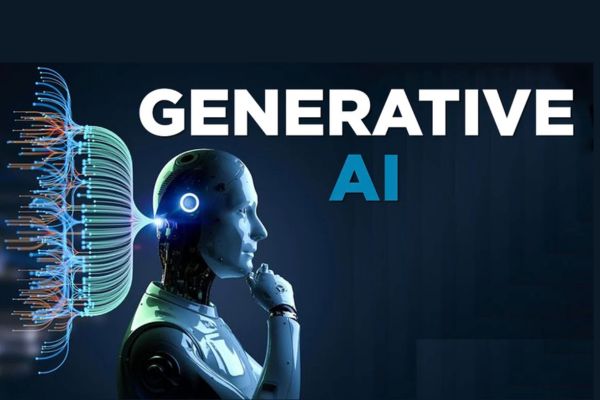The global generative AI market was valued at USD 19.38 billion in 2024 and is projected to reach approximately USD 317.45 billion by 2034, growing at a robust compound annual growth rate (CAGR) of 33.58% between 2025 and 2034.
The market is experiencing rapid expansion, driven by breakthroughs in machine learning, particularly in large language models and neural networks, as well as growing demand for automated and creative content generation. Industries such as entertainment, retail, finance, and marketing are increasingly leveraging generative AI to enhance customer engagement, streamline operations, and personalize user experiences. As AI models become more capable and versatile, their applications are expanding, unlocking new avenues for growth and innovation.
Key factors fueling this growth include rising cloud adoption, increasing venture capital investments, and ongoing advancements in AI research and development. The market’s evolution is also supported by growing acceptance of AI-generated content and its integration into enterprise and consumer applications.
What is Generative AI?
Generative AI refers to artificial intelligence systems capable of creating new content—including text, images, audio, and video—based on patterns learned from large datasets. Unlike traditional AI, which focuses on analyzing or classifying existing information, generative AI produces original content that mimics human creativity.
Examples include:
- ChatGPT (text generation)
- DALL·E (image generation)
- AI music composition tools
OpenAI, a pioneer in generative AI, has received significant investments from Microsoft—including $1 billion in 2019 and $10 billion in 2023—to scale its models and integrate AI into Microsoft products like Azure and Office.
Generative AI has applications across multiple sectors including marketing, design, healthcare, education, and entertainment, enabling businesses to automate content creation and improve efficiency.
Key Highlights
- North America held the largest market share at 40.6% in 2024.
- Asia Pacific contributed 21.3% of total revenue in the same year.
- Transformer models accounted for 45% of the technology segment.
- Software led the component segment with a 65% share.
- Media & entertainment dominated the industry segment with a 24% share.
Generative AI Market in different industries
| Industry | Uses of Generative AI |
|---|---|
| Media & Entertainment | – Scriptwriting and story generation – Special effects and animation creation – Music composition and remixing – Game design (characters, landscapes) |
| Marketing & Advertising | – Personalized ad and email content creation – Automated campaign design – Visual asset generation (images, banners) – Customer engagement tools (chatbots) |
| Healthcare | – Drug discovery and molecular structure generation – Synthetic medical data for research – Medical imaging enhancement – Personalized treatment simulations |
| Finance | – Fraud detection and anomaly generation for simulations – Automated report generation – Predictive financial modeling – Chatbots for customer service |
| Education | – Creation of personalized learning materials – AI tutors and lesson planners – Assessment tools and test question generation – Simulated learning environments |
| Retail & E-commerce | – Product description and review generation – AI-generated fashion designs – Visual try-on solutions using AI avatars – Customer support chatbots |
| Automotive | – Concept car and parts design through generative modeling – Autonomous driving simulation data generation – Predictive maintenance through synthetic data |
| Architecture & Construction | – AI-generated blueprints and floor plans – Design visualization and rendering – Automated 3D modeling and prototyping |
| Legal & Compliance | – Drafting of legal documents and contracts – Automated compliance summaries – Regulatory report generation |
| Gaming | – Procedural content generation (levels, environments) – Dialogue scripting and character behavior modeling – Realistic avatar and asset generation |
Key Market Trends
1. Creative Industry Integration:
Generative AI is transforming creative sectors, allowing rapid production of unique digital content like videos, music, and artwork. This is boosting innovation in marketing, design, and media.
2. AI in Product Design:
AI is being embedded in design workflows for automated prototyping, modeling, and simulation, enhancing product innovation and time-to-market.
3. Personalized Experiences:
Generative AI is driving hyper-personalization in customer service and digital marketing, leading to better engagement and retention through tailored content and product recommendations.
4. Ethical AI Development:
Transparency, fairness, and accountability are gaining importance, prompting companies to focus on responsible development and deployment of generative AI.
5. Rise of Integrated AI Solutions:
Organizations are increasingly combining generative AI with other analytics and automation tools to create end-to-end intelligent systems for business processes.
Segment Analysis
By Technology:
- Generative Adversarial Networks (GANs): Used for realistic image and video generation across advertising, gaming, and simulation.
- Variational Autoencoders (VAEs): Useful in generating smooth, continuous data for image, speech, and personalization applications.
- Transformer Models: Core technology behind advanced language models like GPT-4; widely used for text generation, translation, and conversational AI.
By Application:
- Content Creation: AI-generated articles, marketing copy, and media assets are reshaping journalism, entertainment, and advertising.
- Healthcare: Supports drug discovery, synthetic data creation, and advanced medical imaging interpretation.
- Finance: Enables fraud detection, predictive analytics, and automated reporting by analyzing massive financial datasets.
By Industry:
- Media & Entertainment (24% share in 2024): AI enhances production processes in film, music, and digital media.
- Marketing & Advertising: AI tailors content and campaigns for targeted audiences at scale.
- Education: Develops personalized learning content and tutoring systems for improved educational outcomes.
By End-User:
- Large Enterprises: Use generative AI for innovation, automation, and decision-making at scale.
- SMEs: Adopt AI tools for affordable and efficient content generation, customer engagement, and operations.
- Individual Creators: Utilize AI for creative support, accelerating workflows in art, writing, and media.
Regional Analysis
North America:
Valued at USD 7.87 billion in 2024, projected to reach USD 128.89 billion by 2034. The region dominates due to robust R&D, significant investment, and a mature tech ecosystem. High adoption in enterprise applications and a focus on ethical AI further accelerate growth.
Europe:
Estimated at USD 5.6 billion in 2024, growing to USD 91.74 billion by 2034. Strong support for AI innovation, research funding, and emphasis on ethical AI use positions Europe as a key player, with major contributions from Germany, the UK, and France.
Asia-Pacific:
Valued at USD 4.13 billion in 2024 and expected to reach USD 67.62 billion by 2034. Rapid urbanization, supportive government policies, and expanding tech infrastructure in China, India, and Japan are driving growth.
LAMEA:
Generated USD 1.78 billion in 2024, with projections reaching USD 29.21 billion by 2034. Growth is driven by rising digital transformation in Latin America and major AI investments in the Middle East, despite infrastructural challenges in parts of Africa.
Ask here for more details@ https://www.cervicornconsulting.com/sample/2396

















